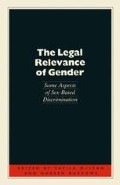Abstract
In the parlance of modern political discourse, to discriminate is to disfavour a person or group on grounds which are irrelevant to the matter in hand in a way which manifests an unreasonable disvaluation of the type of person involved. To count as discrimination, the disfavour — that is, the benefit lost or the burden acquired — need not be deliberately imposed, but it must be the consequence of humanly contrived practices or decisions related to the disvaluing in question. To be born a dwarf is not to be discriminated against, but to be disqualified from voting on the grounds of size, or to be allowed to vote only where the ballot boxes are five feet above the ground, may be. However, there is an added requirement for the disfavour to count as discrimination, namely that the decisions, arrangements or practices involved in the process exhibit or result from prejudice, that is the unreasonable disvaluing or denigration of certain types of person. Discrimination is the perpetration of unjustifiable inequality in consequence of bigotry.
Access this chapter
Tax calculation will be finalised at checkout
Purchases are for personal use only
Preview
Unable to display preview. Download preview PDF.
Notes
This confusion is to some extent unravelled in Jeremy Waldron, ‘Indirect Discrimination’, in S. Guest and A. J. Milne (eds) Equality & Discrimination: Essays in Freedom and Justice ( Stuttgart: Franz Steiner, 1985 ), pp. 93–100.
See D. D. Raphael, Problems of Political Philosophy ( London: Pall Mall, 1970 ), pp. 178f.
On the nature of groups and their relevance to discrimination, see O. M. Fiss, ‘Groups and the Equal Protection Clause’. Philosophy and Public Affairs 5.2 (1971), pp. 107–77, especially pp. 147–56.
See J. W. Nickel, ‘Discrimination and Morally Relevant Characteristics’, Analysis, 32. 4 (1972), pp. 113–14.
However, see R. Dworkin, Taking Rights Seriously (London: Duckworth, 1977), pp. 301, 318 and 330.
See Equal Opportunities Commission, Women and Men in Britain: A Statistical Profile ( Manchester: Equal Opportunities Commission, 1985 ).
See T. D. Campbell, ‘Discretionary Rights’ in N. Timms and D. Watson (eds), Philosophy and Social Work ( London: Routledge & Kegan Paul, 1978 ), pp. 50–77.
W. B. Lockhart, Y. Kamiser and J. H. Choper, Constitutional Law, 5th edn ( Minnesota: West Publishing Company, 1980 ) p. 1413.
See E. Cary and K. W. Peratis, Women and the Law ( Illinois: National Textbook Company, 1979 ), p. 22.
See M. Mead, Male and Female ( Harmondsworth: Penguin, 1962 )
and J. J. Thomson, ‘Preferential Hiring’, Philosophy and Public Affairs, 2. 4 (1973), pp. 364–84.
See B. A. Babcock, A. E. Freedman, E. A. Norton and S. C. Ross, Sex Discrimination and the Law (Boston: Little Brown & Co., 1975), pp. 179ff.
See M. Cohen, T. Nagel and T. Scanlon, Equality and Preferential Treatment (Princeton University Press, 1977 ).
This point is made in W. Sadurski, ‘The Morality of Preferential Treatment’, Melbourne University Law Review, 14 (1984), pp. 572–600.
See J. W. Nickel, ‘Discrimination and Morally Relevant Characteristics’, Analysis 32.4 (1972), pp. 113–14,
W. Nickel, Paul W. Taylor, ‘Reverse Discrimination and Compensatory Justice’ Analysis, 33. 6 (1973), pp. 177–82.
See Alan H. Goldman, Justice and Reverse Discrimination, Princeton University Press, 1979 ), p. 143.
See T. Nagel, ‘Equal Treatment and Compensatory Discrimination’, Philosophy and Public Affairs, 2. 4 (1973), pp. 348–63.
Editor information
Editors and Affiliations
Copyright information
© 1988 Sheila McLean and Noreen Burrows
About this chapter
Cite this chapter
Campbell, T. (1988). Sex Discrimination: Mistaking the Relevance of Gender. In: McLean, S., Burrows, N. (eds) The Legal Relevance of Gender. Palgrave Macmillan, London. https://doi.org/10.1007/978-1-349-19353-0_2
Download citation
DOI: https://doi.org/10.1007/978-1-349-19353-0_2
Publisher Name: Palgrave Macmillan, London
Print ISBN: 978-0-333-40772-1
Online ISBN: 978-1-349-19353-0
eBook Packages: Palgrave Social & Cultural Studies CollectionSocial Sciences (R0)

